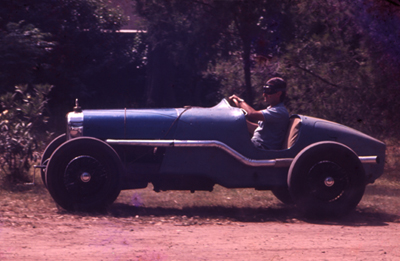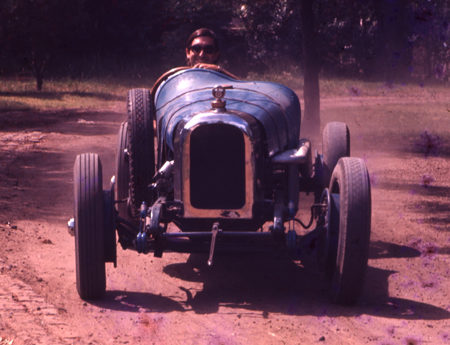

By ENRIQUE SÁNCHEZ ORTEGA
A while ago, Serge Pozzoli, a journalist and world authority on automotive history, wrote in a French magazine: "It's sad, but in my opinion there is no La Perle 6 cylinders in the world." Here, in Buenos Aires, there is one.
"La Perle? ... Perle? No, it does not ring!"
"And ... it's clear ... it's a little known name, but to begin with, let Dr. Fernández Aguirre (a man who knows about cars, racing and history) tell us something about the car.
"Because of a La Perle, the inflamed public set fire to the Autodromo de San Martín, I witnessed the race I had taken as a child, my father, and it turns out that the public had a favorite: Perín and his Bugatti This runner enjoyed the sympathy of most of those who frequented the weekends assiduously to see the fabulous braids that were assembled in that circuit, then, with the passing of the months, Perín would become what we would qualify today. as an idol, when in the singular tournament he was defeated, after an implacable fight with Bucci's Hudson in the Rafaela 500 of 1927.
But let's go back to the day of La Perle. This unknown little French machine was driven by a Frenchman who had stood out for a strange peak-shaped leather mask that he put on to protect himself from dust in the races. The French aspect was impressive and grotesque ...
That day "like so many others" the favorite of the rostrum was Perín. At the start of the race, the Bugatti takes the lead. Some laps pass and La Perle stops. Change tires and continue in the race. By then, the Bugatti had already discounted one or more laps (and it seems that the two were left alone in the race). Detail that did not take into account the planners, who, when resuming the La Perle and its position in the circuit, gave it as a leader of the race without discounting the laps. Then the public's outrage broke out. Indignation that reached its peak when, at the end of the race, they gave him the winner of La Perle.
Then the passion arose. The protests and everything else. But as the authorities did not reconsider the result, and faced with such injustice, followers of the Bugatti did not find a better form of protest than burning the stands that were made of wood. This destroyed the primitive San Martin Racetrack, which was later rebuilt. Also Borocotó in his book Medio Siglo de Automovilismo Argentino made reference to this La Perle. Telling us about the Autodromo de San Martín, he says: "There was a lot of La Perle machine, it was in all of them, it never failed ... in the games, then yes, in the starting line we saw it firm, consistent. As long as it happened, but one day I was going to win, yes, gentlemen, it was the afternoon of La Perle! I was running on the edge and away from its adversaries ... who had stopped, it was the first and last one at the same time. He could not lose, however, he lost, the race was suspended because the night came. "
And this is surely the La Perle that appeared one day on Cramer Street. He had been thrown out to the weather for 26 years so that, already evicted, he found Oscar Tavelli, a quasi debutante collector of how many Bugatti or Bugatti piece is loose on these floors. To this insatiable restorer, the information of the whereabouts of La Perle arrived by some more or less unusual route, as is often the case. He bought it for a presumably unusual number as well, as it usually does in these cases, and there his condition began. "I broke two wooden mallets trying to take off the pistons of the cylinders." The car was quite complete, just missing the compressor, which at the time of disarmament and Tavelli himself knew that equipped the factory engine. He investigated and learned that, since the car had been abandoned to the weather in that yard, the owner had removed the supercharger to give it to a friendly mechanic, who would put it in the engine of a "racing" car in construction. Inexplicably, the Cozette No. 8 compressor was still in the back of this mechanic's house and had never been used.
It is understandable that you keep asking yourself: "Very well, this Mr. Tavelli found it and fixed it ... But, what did he find, what did he arrange, what is" please tell us! "this unknown La Perle?
The first La Perle was a bicycle. That is to say, an elementary car, crude, of small dimensions, small displacement. A cross between the motorcycle and the car. It was built by Mr. Louis Lefevre in Boulogne-sur-Seine immediately before the First World War. This prototype was powered by a two-cylinder in-line engine cooled by water and with the opposite intake and exhaust valves. The gearbox was of the friction type and the transmission to the rear wheels was done by a pair of leather straps.
In 1921, Franz Lefevre joined his brother Louis and between the two faced the purchase of five Bignan engines of 1400 cm3 (61 × 119 mm) like those used in the Grand Prix de voiturettes of the previous year. These engines were designed by Causan, with steel pistons, tubular cams as was fashionable at the time, and delivered only 27 HP at 3000 rpm; they were mounted on the same number of Malicet and Blin chassis and they were designed with a conical tail body and two seats. These cars were made so that in the Voiturettes Cup of 1921 they were driven by Louis Lefevre, Carteau and Revaux. Unfortunately for the brothers, the engines tended to overheat, a problem coupled with a defect in the Zenith carburetors (Carteau was employed by the Zenith house), and the best they could do in the test was to get a fifth behind three Talbot-Darracq and a Hillman. In Boulogne, the same year, Louis Lefevre won his first victory. The three cars of the team also went to Spain that same year for the Penya-Rhin race that was played under the formula of 1400 cm3 at the Villafranca circuit. Lefevre broke his car on the road from France to Spain, but it was repaired in such a way that he punctured the race, until an oil spout stopped driving oil. Revaux had the bad luck to break a connecting rod, but the mechanics of Elizalde's box (a refined Spanish car of the time) managed to adjust the broken rod ... and Revaux finished third behind two Bugatti type 13.
There were two different types of La Perle in 1921: one of them had no front brakes or central locking wheels, while the other had wheels type R.A.F. and four-wheel brakes.
In 1922, the La Perle began to be commercialized. The chassis was similar to the 1921 model, with brakes on all four wheels, and the engine was based on that of 1400 cm3. In this case it was also designed by Causan, but the dimensions of cylinders had been increased to 63 × 119 mm. The block was cast iron and the two camshafts commanded the valves through rods. The suspension was classic, with four semi-elliptical elastics. Rudge type central fixation hubs were also added. Around 300 cars of this model were sold, most of them with elongated bodies of two seats.
1924 was another year of success for La Perle. Louis Lefevre won a number of victories for the house, most of them in the class for production cars.
At the end of that year, at the Paris Motor Show, La Perle proudly presented its new six-cylinder model, also of 1500 cm, while the four-cylinder model remained in production as an economic option. The chassis of the six maintained the design of the four, although slightly larger. The engine "design also of Causan" was six in line of 60 × 88 mm diameter / stroke, with a camshaft to the head. The cams acted directly on the stem of the valves and the springs of these were enclosed in perforated cylinders, whose function was to avoid the loss of pressure. The crankshaft rotated on four benches. By then the power came from a pair of Solex carburetors ablated directly to the cylinder head. The weight of the chassis was increased to 650 kg, although some of these six cylinders were built using the smaller chassis of the four-cylinder models. The wheels were Roudge, but the brakes were changed by the Hersot system. The speed of the car was really admirable by then (for 1924 and for a car of 1500 cm3). The Grand Sport four-seat model reached 128 km / h, the two-seat Grand Sport traveled at 140 km / h maximum, while the Tourism gave 100 km / h as a stop, and with luck. An elegant model with a Weymann bodywork that reached 140 km / h was also built. Around 75 cars of these six cylinders were built in total. Most were Grand Sport and pure competition models. In the latest versions, with the same engine reached 154 km / h, by 62 HP at 4200 rpm.
The Tavelli car that we present is one of the very rare six cylinders built on the chassis of the four-cylinder model. There are no data, but according to Serge Pozzoli, who, among other things, is president of the Association of Friends of the History of the Automobile, it is a 1925 model transformed. And the only six cylinder currently located in the world. In total, the house produced 375 cars.
The La Perle factory closed everything in 1927, but Franz Lefevre continued running with some success. The following year, Lefevre's car, a six-cylinder, was modified. The chassis was lowered and front Perrot-Piganeau brakes and axles were fitted. The engine "here comes the suggestive and interesting to the mystery of the history of La Perle that occupies us in Argentina" overfed (as something completely out of the box) with a compressor Cozette No. 8. With this modification the car reached 170 km / h while the engine was running at 4500 rpm.
The first sporting appearance of the refurbished car was in Pau, where the Grand Prix de France was played. Driven by Casoli, the car was the second 1500 cm when crossing the finish line behind the Delage 1500 from Senechal (official team car Delage). The same pilot also won a second place in the Marne Grand Prix that year, possibly also in the 1500 class. In 1931, Franz Lefevre settled on the Côte d'Azur and there he built by hand a prototype with an armed body on his La Perle career. It turned out to be a nice apparatus of true advanced lines that deserved to obtain the highest distinction in various elegant contests of the time. A replica of this car was built using new parts, and that would be the last car that would carry the forgotten name of La Perle.
ARTICLES OF VOLUME I

 ... and the ACA lets them die
... and the ACA lets them die
 La Perle 1925 6 cil
La Perle 1925 6 cil
 Macoco
Macoco
| Contact: (+549) 11 4027 8262 / sancho1978@gmail.com |
| Home | Volume I | Volume II | Volume III | News | Photo Gallery | Contact |